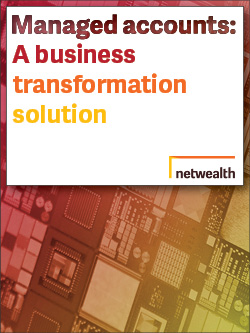Take outs:
- Managed accounts are a new investment solution available to consumers and financial advisers looking for greater control, transparency and efficiencies.
- Improvements in technology and consumer expectations have seen managed accounts evolve to now include a broad range of offerings.
- Managed accounts have benefits for consumers and advisers and should be assessed from these perspectives.
Technological advances and changes in consumer expectations have led to a new investment solution and investment technology now available in the marketplace.
These are called managed accounts.
While not new to Australia, managed accounts are quickly gaining pace in the Australian marketplace because they have benefits for both financial advisers who recommend them, and consumers who invest with them.
According to the Institute of Managed Account Professionals, as at 30 June 2017, managed accounts represented more than $47 billion in funds under management and are growing.
The number of providers is also increasing, as a new wave of managed accounts are launched utilising the advancements in technology and new entrants jump into a bourgeoning opportunity.
In the recent Netwealth AdviceTech Research Report published in June 2017, 35% of the more than 200 financial advisers who responded said they currently use a managed account with their clients. A further 22% said they intend to use them in the next 18 months and 27% are considering them.
What is a managed account?
A managed account, or sometimes referred to as a SMA (separately managed account), is a portfolio of individual securities or assets managed on an investors behalf by a professional investment manager. The individual securities or assets are held in the investors account, often on a super or investment platform, to provide control, transparency and potential tax benefits.
From an adviser’s perspective, a managed account is more. It provides an effective tool to manage multiple client portfolios in a cost efficient and professional way. Effectively it provides a 'whole-of-business' solution that can add consistency and reliability to the investment processes, transforming the way it does business.
Of benefit to investors
Managed accounts give investors access to a range of professionally managed multi-asset investment models which can be tailored to an individual's risk profile and wealth objectives.
In managed accounts, the investor holds the underlying asset. Knowing exactly where they are invested and the actual underlying assets in an investment is considered a benefit for investors. Not only does it offer transparency, but control, so if they want to exclude assets from a portfolio, it can be done.
Tax effectiveness is another benefit of managed accounts. Investors tax benefits and gains are attributed to their own holdings and not netted out by other investor actions as is the case in other investments where the money is pooled.
For investors, wanting to learn more about the Netwealth Managed Account solution, click here.
Of benefit to financial advisers
Managed accounts represent a new wave of platform technology for advisers and dealer groups. They have the potential to deliver consistency and reliability to the investment management process in ways that previously were not as easy or cost effective. Their use can create a consistent investment process where clients know what to expect and are clear about the value proposition. With this comes a more scaleable and hopefully reliable business model – a foundation for future growth.
Originally from the US, managed accounts have been in the Australian market for more than a decade. In that time, they have evolved and grown largely driven by advances in technology, so today, advisers have a several managed account structures or options to choose from. These include platform-based managed accounts (MAs) or a managed discretionary account (MDA) service, on or off a platform.
Advisers have the option to:
- Establish a ‘private label’ on their preferred super and investment platform - Construct models that reflect their own investment philosophy and style, using an external license often provided by the platform
- Become an MDA provider - Apply for an MDA provider authorisation and continue to use their preferred platform if it supports the operation of the model/s
- Utilise a platform’s public menu MA models - Increase their approved products list (APL) and utilise MAs on their preferred platform
- Become an external MDA Adviser - Engage a specialist MDA provider who offer their models and advise on this service
- Utilise a third party MA responsible entity (RE) – Although some platforms may not offer a facility for the platform operator to be the responsible entity of a licensee-specific MA, they will support an external responsible entity acting in this capacity.
To learn more about the pros and cons of each different option, download our latest report on managed accounts.
Although managed accounts are not for everyone, understanding them can be a useful exercise for both investors and advisers alike.
Managed accounts: A business transformation solution
Better understand the different types of managed account structures that are available and their pros and cons
